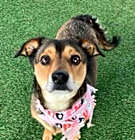Color
Brown/Chocolate
Size
(when grown) Med. 26-60 lbs (12-27 kg)
Details
Not good with kids
Not good with dogs
Not good with cats
Spayed or Neutered
Story
Hi, I'm Cherry, a sweet and loving beagle girl! I love every person that I meet and adore other dogs. I'm only 6-years-old, but up until now, I lived a lonely and sad life-- before being rescued, I was sick, hungry, and forced to live outside in all kinds of harsh weather while being used to breed puppies... Now that I'm safe with Beagle Freedom Project, I'm getting the love and medical care that I've spent years without. During my first exam with BFP's vet, the doctor found a growth in my throat that is consistent with cancer. At this point, the growth is inoperable. I wish more than anything that my previous family would have cared enough about me to provide me with veterinary care-- maybe then, this mass could have been discovered sooner, when I would've still had more treatment options. That being said, despite everything that I've been through and my diagnosis, I am still the happiest little sweetheart. I am the true portrait of resilience, strength, and love! While vets aren't sure how much time I have left, I sure hope I can spend my golden years with a caring and compassionate family who will keep me comfortable for as long as they possibly can. Could you give me the home I've always dreamed of?
My ideal home: A household with another friendly dog.
My location: NOWATA, OK
*Please note that third-party sites like PetFinder or Adopt-a-Pet may sometimes list multiple locations for the same animal. My correct and current location is the one listed directly above!*
*Beagle Freedom Project facilitates out-of-state adoptions, provided the adopter is able to travel to the animal's current location for pickup.*
If you are interested in adopting me, please fill out an adoption application at https://bfp.org/adopt/
Please email the Beagle Freedom Project Team with questions at: adopt@bfp.org.
ABOUT BEAGLE FREEDOM PROJECT: Beagle Freedom Project is the world's leading organization for rescuing and rehoming animals used in experimental research. If you would like to learn more about our organization, visit our site: https://bfp.org/













